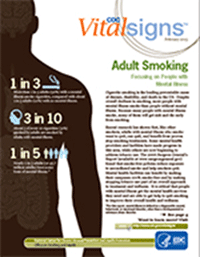Get Ready...Set...Quit!
 The American Cancer Society Great American Smokeout is the perfect starting point.
The American Cancer Society Great American Smokeout is the perfect starting point.
If you’re a smoker, setting a date to quit can be an important step in protecting your health and the health of your loved ones. The American Cancer Society Great American Smokeout encourages smokers to make a plan to quit, or to plan in advance and quit smoking on a specific day. This year, the 41st annual Great American Smokeout will be held on November 17 and will encourage the 36.5 million adults in the U.S. who smoke cigarettes to quit.
Many loved ones have probably urged you to quit smoking already, and you’ve probably wanted or tried to quit. We know that quitting can be hard, but don’t give up. Just as every successful goal starts with planning and preparation, so too does quitting. When you plan to quit smoking during the Great American Smokeout, you are celebrating this day with millions of other smokers across the nation who also want to quit. Join in by participating in social media conversations, chatting live with a counselor or calling a quitline, or teaming up with friends, family, or co-workers for encouragement. Smokers who have support are more likely to quit for good!

Setting a quit date puts you one step closer to your goal of quitting smoking.
Five Ways to Get Ready to Quit Smoking
You’re taking an important step toward feeling better and creating a healthier life when you set out to quit smoking cigarettes. A good plan can help you get past symptoms of withdrawal. Take these five steps to improve your success:
- Set a quit date. Choose the Great American Smokeout or another quit day within the next 2 weeks.
- Tell your family and friends about your quit plan. Share your quit date with the important people in your life and ask for support. A daily phone call, e-mail, or text message can help you stay on course and provide moral support.
-
Be prepared for challenges. The urge to smoke is short—usually only 3 to 5 minutes, but those moments can feel intense. Even one puff can feed a craving and make it stronger. Before your quit day, write down healthy ways to cope.
- Drink water.
- Exercise.
- Listen to a favorite song or play a game.
- Call or text a friend.
- Get social support by joining @CDCTobaccoFree on Facebook and Twitter.
- Sign up for SmokefreeTEXT for 24/7 help on your mobile phone.
- Remove cigarettes and other tobacco from your home, car, and workplace. Throw away your cigarettes, matches, lighters, and ashtrays. Clean and freshen your car, home, and workplace. Old cigarette odors can cause cravings.
- Talk to your pharmacist, doctor, or quitline coach about quit options. Nicotine patches, gum, or other approved quit medication can help with cravings.
In Focus: Smoking and Mental Health
You may already know that smoking causes immediate damage to your body and that it threatens your future with increased risks for cancer, heart attack, lung disease, and early death. But did you know that one group of people especially vulnerable to high rates of smoking are adults with mental distress* disorders and people with mental health conditions such as anxiety and depression? More than 3 in every 10 cigarettes smoked by adults in the United States are smoked by persons with mental health conditions.
 Focusing on People with Mental Illness
Focusing on People with Mental Illness
Recent research has shown that, like other smokers, adults with mental illness who smoke want to quit, can quit, and benefit from proven stop-smoking treatments.

Running helped Rebecca to manage stress and depression and to stay smokefree.
Rebecca’s Story: Rebecca started smoking cigarettes as a teenager and eventually used cigarettes to help her cope with depression. Since quitting smoking, Rebecca has a new outlook on life. She began running while taking her grandson along for a ride in his stroller. This helped her to manage stress and depression and to stay smokefree. “Running became the way I felt better,” Rebecca says. “When I have a bad day or feel a little stressed out, I just go for a run and I’m back on track. “Rebecca’s story is included in CDC’s national tobacco education campaign, Tips From Former Smokers™, and in a video entitled “Rebecca’s Tip.”
* Psychological distress is measured by levels of sadness, nervousness, restlessness, worthlessness, and feeling like everything is an effort.
Why Do You Want to Quit?
Perhaps you want to live a healthier life, live longer for your family members, or save the money that you’d typically spend on cigarettes. Write down your reasons for quitting, no matter what motivates you to make this decision. Refer to the list whenever you have the urge to smoke. It will help remind you of all the reasons you want to quit. Rebecca knew quitting would make her feel better mentally and physically. She says, “I finally realized I had to look to myself for my own happiness and health. I had to quit.”
You Can Do It!
Making the decision to quit can help you realize and appreciate your own determination! You have the strength it takes to quit smoking for good. The support provided by the American Cancer Society Great American Smokeout doesn’t end when the day is over. The following free resources can help you quit:
- 1-800-QUIT-NOW (1-800-784-8669)
- 1-855-DÉJELO-YA (1-855-335-3569)
- Smokefree.gov
- Espanol.smokefree.gov
- Tips From Former Smokers
- Quit Tobacco
- Help for Smokers and Other Tobacco Users (booklet) [178 KB]
- American Cancer Society—The Great American Smokeout
- Page last reviewed: November 14, 2016
- Page last updated: November 14, 2016
- Content source:
- National Center for Chronic Disease Prevention and Health Promotion, Office on Smoking and Health
- Page maintained by: Office of the Associate Director for Communication, Digital Media Branch, Division of Public Affairs




 ShareCompartir
ShareCompartir